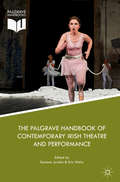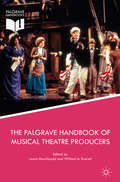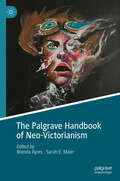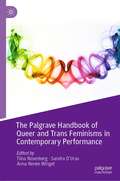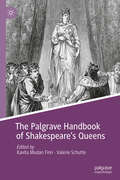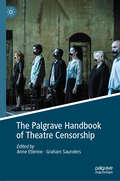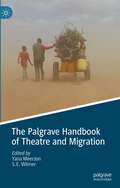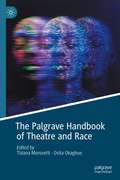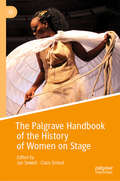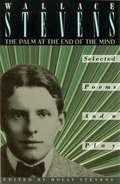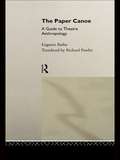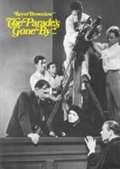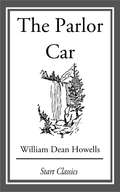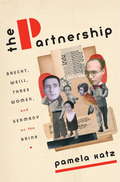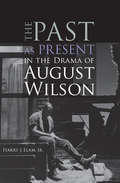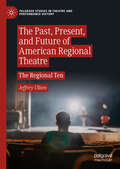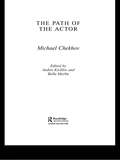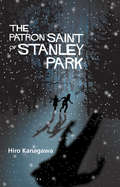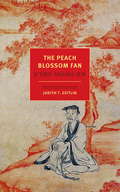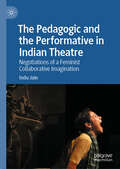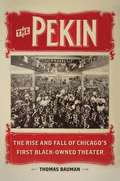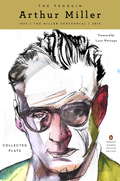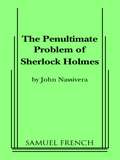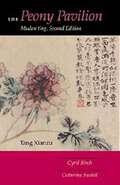- Table View
- List View
The Palgrave Handbook of Contemporary Irish Theatre and Performance
by Eric Weitz Eamonn JordanThis Handbook offers a multiform sweep of theoretical, historical, practical and personal glimpses into a landscape roughly characterised as contemporary Irish theatre and performance. Bringing together a spectrum of voices and sensibilities in each of its four sections — Histories, Close-ups, Interfaces, and Reflections — it casts its gaze back across the past sixty years or so to recall, analyse, and assess the recent legacy of theatre and performance on this island. While offering information, overviews and reflections of current thought across its chapters, this book will serve most handily as food for thought and a springboard for curiosity. Offering something different in its mix of themes and perspectives, so that previously unexamined surfaces might come to light individually and in conjunction with other essays, it is a wide-ranging and indispensable resource in Irish theatre studies.
The Palgrave Handbook of Musical Theatre Producers
by William A. Everett Laura MacdonaldThis handbook is the first to provide a systematic investigation of the various roles of producers in commercial and not-for-profit musical theatre. Featuring fifty-one essays written by international specialists in the field, it offers new insights into the world of musical theatre, its creation and its promotion. Key areas of investigation include the lives and works of producers whose work is part of a US and worldwide musical theatre legacy, as well as the largely critically-neglected role of the musical theatre producer in the making, marketing, and performance of musicals. Also explored are the shifting roles of producers in musical theatre and their popular portrayals, offering a reader-friendly collection for fans, scholars, students, and practitioners of musical theatre alike.
The Palgrave Handbook of Neo-Victorianism
by Brenda Ayres Sarah E. MaierThis handbook offers analysis of diverse genres and media of neo-Victorianism, including film and television adaptations of Victorian texts, authors’ life stories, graphic novels, and contemporary fiction set in the nineteenth century. Contextualized by Sarah E Maier and Brenda Ayres in a comprehensive introduction, the collection describes current trends in neo-Victorian scholarship of novels, film, theatre, crime, empire/postcolonialism, Gothic, materiality, religion and science, amongst others. A variety of scholars from around the world contribute to this volume by applying an assortment of theoretical approaches and interdisciplinary focus in their critique of a wide range of narratives—from early neo-Victorian texts such as A. S. Byatt’s Possession (1963) and Jean Rhys’ Wide Sargasso Sea (1966) to recent steampunk, from musical theatre to slumming, and from The Alienist to queerness—in their investigation of how this fiction reconstructs the past, informed by and reinforming the present.
The Palgrave Handbook of Queer and Trans Feminisms in Contemporary Performance
by Tiina Rosenberg Sandra D’Urso Anna Renée WingetThe purpose of this Handbook is to provide students with an overview of key developments in queer and trans feminist theories and their significance to the field of contemporary performance studies. It presents new insights highlighting the ways in which rigid or punishing notions of gender, sexuality and race continue to flourish in systems of knowledge, faith and power which are relevant to a new generation of queer and trans feminist performers today.The guiding question for the Handbook is: How do queer and trans feminist theories enhance our understanding of developments in feminist performance today, and will this discussion give rise to new ways of theorizing contemporary performance? As such, the volume will survey a new generation of performers and theorists, as well as senior scholars, who engage and redefine the limits of performance. The chapters will demonstrate how intersectional, queer and trans feminist theoretical tools support new analyses of performance with a global focus. The primary audience will be students of theatre/ performance studies as well as queer /gender studies. The volume’s contents suggest close links between the formation of queer feminist identities alongside recent key political developments with transnational resonances. Furthermore, the emergence of new queer and trans feminist epistemologies prompts a reorientation regarding performance and identities in a 21st-century context.
The Palgrave Handbook of Shakespeare's Queens (Queenship and Power)
by Valerie Schutte Kavita Mudan FinnOf Shakespeare’s thirty-seven plays, fifteen include queens. This collection gives these characters their due as powerful early modern women and agents of change, bringing together new perspectives from scholars of literature, history, theater, and the fine arts. Essays span Shakespeare’s career and cover a range of famous and lesser-known queens, from the furious Margaret of Anjou in the Henry VI plays to the quietly powerful Hermione in The Winter’s Tale; from vengeful Tamora in Titus Andronicus to Lady Macbeth. Early chapters situate readers in the critical concerns underpinning any discussion of Shakespeare and queenship: the ambiguous figure of Elizabeth I, and the knotty issue of gender presentation. The focus then moves to analysis of issues such as motherhood, intertextuality, and contemporary political contexts; close readings of individual plays; and investigations of rhetoric and theatricality. Featuring twenty-five chapters with a rich variety of themes and methodologies, this handbook is an invaluable reference for students and scholars, and a unique addition to the fields of Shakespeare and queenship studies.
The Palgrave Handbook of Theatre Censorship
by Graham Saunders Anne EtienneThis book incorporates a wide theoretical, cultural, literary and historical engagement in exploring the tension between dramatic productions and the forms of censorship they encounter from creation to reception. The Palgrave Handbook of Theatre Censorship offers global new insights into censorship practices, examining attempts at repression motivated either by fears that audiences gathering together to watch live dramatic events will lead to sedition and mass uprisings, or by moral or religious squeamishness requiring the establishment of institutional systems of censorship to curb or suppress the stage. As such, the Handbook aims to initiate redefinitions of what we understand or experience as censorship. Who knew theatre could (still) carry so many threats, or be so widely provocative and dangerous? This is an extraordinary and often eye-opening set of thirty-six individually insightful, wide-ranging and oftentimes disturbing essays, each of which offers unique insights into theatre censorship practices and their impact within a specific political and moral culture. There is a particular emphasis on the recent and current, and the authors speak with first-hand knowledge and from direct experience not only about the restrictions but also how artists sometimes negotiate and evade these. What makes the book so especially fascinating and illuminating is seeing so many examples juxtaposed together. This enables the reader to hear the essays and the cultures talking to and alongside each other. The collection repeatedly breaks fresh ground, and the editors deserve enormous credit for gathering and effectively curating so many reports from the front-line. Steve Nicholson, Emeritus Professor, University of Sheffield, UK Anne Etienne and Graham Saunders’s book is a wide-ranging, incisive and compelling collection of reflections and case studies on the theatre industry’s relationship to censorship and self-censorship from a historical and contemporaneous perspective. An impressive array of authors have been assembled for this volume representing, among them, views on the subject from Spain, Denmark, Norway, Zimbabwe, South Africa, Germany, Italy, Indonesia, Iran, Portugal, Turkey, Brazil, Japan, Ireland, Australia, Russia, England and more. The book is by turns surprising in its curatorial and narrative design and wonderfully effective at delineating the complex and thorny paths that create socio-political cultures where the censorship and self-censorship of theatre artists thrives and/or is efficaciously contested and rebelled against. Of note is a through line of argument in the book around less overt modes of surveillance that police artists’ imaginations and thereby the work they create and produce. At a time in the world where many governments are increasingly seeking to limit artistic expression, this book is a necessary reminder of the many freedoms that have been fought for in theatres around the globe, and how the power of being unsilenced must never be taken for granted. – Caridad Svich. Playwright & Translator This is a truly excellent collection of incisive studies. It is wide-ranging, impressively global in scope, with an illuminating balance of the historical and the contemporary. In its impressive and well-realised ambition, demonstrated by the well-focused intelligence and academic flair of its many contributors, this collection is both magisterial and vital. It is an essential contribution to censorship studies, fascinating and inspiring, a must-read for anyone interested in the subject. – Aleks Sierz. Theatre critic and author of Rewriting the Nation: British Theatre Today (2011) & Good Nights Out: A History of British Theatre Since the Second World War (2021)
The Palgrave Handbook of Theatre and Migration
by Yana Meerzon S. E. WilmerThe Palgrave Handbook of Theatre and Migration provides a wide survey of theatre and performance practices related to the experience of global movements, both in historical and contemporary contexts. Given the largest number of people ever (over one hundred million) suffering from forced displacement today, much of the book centres around the topic of refuge and exile and the role of theatre in addressing these issues. The book is structured in six sections, the first of which is dedicated to the major theoretical concepts related to the field of theatre and migration including exile, refuge, displacement, asylum seeking, colonialism, human rights, globalization, and nomadism. The subsequent sections are devoted to several dozen case studies across various geographies and time periods that highlight, describe and analyse different theatre practices related to migration. The volume serves as a prestigious reference work to help theatre practitioners, students, scholars, and educators navigate the complex field of theatre and migration.
The Palgrave Handbook of Theatre and Race
by Tiziana Morosetti Osita OkagbueThe first comprehensive publication on the subject, this book investigates interactions between racial thinking and the stage in the modern and contemporary world, with 25 essays on case studies that will shed light on areas previously neglected by criticism while providing fresh perspectives on already-investigated contexts. Examining performances from Europe, the Americas, the Middle East, Africa, China, Australia, New Zealand, and the South Pacifi c islands, this collection ultimately frames the history of racial narratives on stage in a global context, resetting understandings of race in public discourse.
The Palgrave Handbook of the History of Women on Stage
by Jan Sewell Clare SmoutThis book brings together nearly 40 academics and theatre practitioners to chronicle and celebrate the courage, determination and achievements of women on stage across the ages and around the globe. The collection stretches from ancient Greece to present-day Australasia via the United States, Soviet Russia, Europe, India, South Africa and Japan, offering a series of analytical snapshots of women performers, their work and the conditions in which they produced it. Individual chapters provide in-depth consideration of specific moments in time and geography while the volume as a whole and its juxtapositions stimulate consideration of the bigger picture, underlining the challenges women have faced across cultures in establishing themselves as performers and the range of ways in which they gained access to the stage. Organised chronologically, the volume looks not just to the past but the future: it challenges the very notions of ‘history’, ‘stage’ and even the definition of ‘women’ itself.
The Palm at the End of the Mind: Selected Poems and a Play
by Wallace Stevens Holly StevensA collection that all the major long poems and sequences, and every shorter poem of lasting value in Stevens' career. Edited by Holly Stevens, it includes some poems not printed in his earlier Collected Works.From the Trade Paperback edition.
The Paper Canoe: A Guide to Theatre Anthropology
by Eugenio BarbaFirst published in 1994. Routledge is an imprint of Taylor & Francis, an informa company.
The Parade's Gone By
by Kevin BrownlowThe magic of the silent screen, illuminated by the recollections of those who created it.
The Parlor Car
by William Dean HowellsWilliam Dean Howells (1837-1920) was an American realist author and literary critic. He wrote his first novel, Their Wedding Journey, in 1871, but his literary reputation really took off with the realist novel A Modern Instance, published in 1882, which describes the decay of a marriage. His 1885 novel The Rise of Silas Lapham is perhaps his best known, describing the rise and fall of an American entrepreneur in the paint business. His social views were also strongly reflected in the novels Annie Kilburn (1888) and A Hazard of New Fortunes (1890). While known primarily as a novelist, his short story "Editha" (1905) - included in the collection Between the Dark and the Daylight (1907) - appears in many anthologies of American literature. Howells also wrote plays, criticism, and essays about contemporary literary figures such as Ibsen, Zola, Verga, and, especially, Tolstoy, which helped establish their reputations in the United States. He also wrote critically in support of many American writers. It is perhaps in this role that he had his greatest influence.
The Partnership
by Pamela KatzAmong the most creative and outsized personalities of the Weimar Republic, that sizzling yet decadent epoch between the Great War and the Nazis' rise to power, were the renegade poet Bertolt Brecht and the rebellious avant-garde composer Kurt Weill. These two young geniuses and the three women vital to their work--actresses Lotte Lenya and Helene Weigel and writer Elizabeth Hauptmann--joined talents to create the theatrical and musical masterworks The Threepenny Opera and The Rise and Fall of the City of Mahagonny, only to split in rancor as their culture cracked open and their aesthetic and temperamental differences became irreconcilable. The Partnership is the first book to tell the full story of Brecht and Weill's impulsive, combustible partnership, the compelling psychological drama of one of the most important creative collaborations of the past century. It is also the first book to give full credit where it is richly due to the three women whose creative gifts contributed enormously to their masterworks. And it tells the thrilling and iconic story of artistic daring entwined with sexual freedom during the Weimar Republic's most fevered years, a time when art and politics and society were inextricably mixed.
The Past as Present in the Drama of August Wilson
by Harry J. Elam Jr.Pulitzer-prizewinning playwright August Wilson, author of Fences, Ma Rainey's Black Bottom, and The Piano Lesson, among other dramatic works, is one of the most well respected American playwrights on the contemporary stage. The founder of the Black Horizon Theater Company, his self-defined dramatic project is to review twentieth-century African American history by creating a play for each decade. Theater scholar and critic Harry J. Elam examines Wilson's published plays within the context of contemporary African American literature and in relation to concepts of memory and history, culture and resistance, race and representation. Elam finds that each of Wilson's plays recaptures narratives lost, ignored, or avoided to create a new experience of the past that questions the historical categories of race and the meanings of blackness. Harry J. Elam, Jr. is Professor of Drama at Stanford University and author of Taking It to the Streets: The Social Protest Theater of Luis Valdez and Amiri Baraka (The University of Michigan Press).
The Past, Present, and Future of American Regional Theatre: The Regional Ten (Palgrave Studies in Theatre and Performance History)
by Jeffrey UllomThis book provides an overall history of the regional theatre movement in the US, while also utilizing specific accomplishments and failures in addition to crucial administrative and artistic decisions to chart larger developments in American theatre, most notably the craze for new play development, the death of resident companies in professional theatres, the passion to reflect social causes (especially social justice and the #MeToo movement), and the troubling economic state of contemporary regional theatres. The wide-ranging topics in the book examine all aspects of theatre, including its creation and reception, and provide the reader with an interdisciplinary understanding of how the establishment and growth of regional theatres reflected local economic and social developments.
The Path Of The Actor
by Michael ChekhovThis is the first English translation of Michael Chekhov’s two-volume autobiography, combining The Path of the Actor (1927) and extensive extracts from his later volume Life and Encounters. Full of illuminating anecdotes and insightful observations involving prominent characters from the MAT and the European theatre of the early twentieth century, Chekhov takes us through events in his acting career and personal life, from his childhood in St. Petersburg until his emigration to Latvia and Lithuania in the early 1930s. Accompanying Chekhov's witty, penetrating, and immensely touching accounts are extensive and authoritative notes compiled by leading Russian Chekhov scholar, Andrei Kirillov. Anglo-Russian trained actor Bella Merlin provides a useful hands-on overview of how the contemporary practitioner might utilise and develop Chekhov's ideas. Chekhov was arguably one of the greatest actors of the twentieth century. His life made a huge impact on his profession, and his actor-training techniques inspired many a Hollywood legend – including such actors as Anthony Hopkins and Jack Nicholson -while his books outlining his teaching methods and philosophy of acting are still bestsellers today The Path of the Actor is an extraordinary document which allows us unprecedented access into the life, times, mind and soul of a truly extraordinary man.
The Patron Saint of Stanley Park
by Hiro KanagawaSiblings Josh and Jennifer are coping with the loss of their father, who disappeared in a floatplane accident last Christmas Eve. Their mother wants to pretend everything is normal, while Jennifer is angry and isolated and Josh scours the Internet for proof that their father is still alive. So on Christmas Eve, when the children are supposed to catch a bus to their uncle's place, they go to Stanley Park instead and make their way to Prospect Point to honour their father's memory. When a catastrophic windstorm thwarts their plans, Skookum Pete, a strange vagabond who roams the park, takes them to a fantastical bunker beneath the park, where they experience wondrous visions that help them understand the truth about their father.
The Peach Blossom Fan
by Chen Shih-Hsiang Cyril Birch K'Ung Shang-Jen Judith T. Zeitlin Harold ActonA tale of battling armies, political intrigue, star-crossed romance, and historical cataclysm, The Peach Blossom Fan is one of the masterpieces of Chinese literature, a vast dramatic composition that combines the range and depth of a great novel with the swift intensity of film. In the mid-1640s, famine sweeps through China. The Ming dynasty, almost 300 years old, lurches to a bloody end. Peking falls to the Manchus, the emperor hangs himself, and Ming loyalists take refuge in the southern capital of Nanking. Two valiant generals seek to defend the city, but nothing can overcome the corruption, decadence, and factionalism of the court in exile. The newly installed emperor cares for nothing but theater, leaving practical matters to the insidious Ma Shih-ying. Ma's crony Juan Ta-ch'eng is as unscrupulous an operator as he is sophisticated a poet. He diverts resources from the starving troops in order to stage a spectacular production of his latest play. History, however, has little time for make-believe, though the earnest members of the Revival Club, centered on the handsome young scholar Hou Fang-yü and his lover Fragrant Princess, struggle to discover a happy ending.
The Pedagogic and the Performative in Indian Theatre: Negotiations of a Feminist Collaborative Imagination
by Indu JainThis book foregrounds the realm of Contemporary Indian Feminist Theatre in order to explore the inter-relationships between feminist theatrical theory, practice and its historical antecedents. The study focuses on the performance processes, training methods and pedagogical vocabulary used by four Indian women directors: Anamika Haksar, Anuradha Kapur, Kirti Jain and Tripurari Sharma. The book interprets the feminist emphasis on process as extended into actor training and rehearsal dynamics, investigating its innovations as well as limitations, while examining how successful these director-pedagogues were in bringing gendered and radical feminist sensibilities to their work in classroom spaces.
The Pekin: The Rise and Fall of Chicago's First Black-Owned Theater
by Thomas BaumanIn 1904, political operator and gambling boss Robert T. Motts opened the Pekin Theater in Chicago. Dubbed the "Temple of Music," the Pekin became one of the country's most prestigious African American cultural institutions, renowned for its all-black stock company and school for actors, an orchestra able to play ragtime and opera with equal brilliance, and a repertoire of original musical comedies. A missing chapter in African American theatrical history, Bauman's saga presents how Motts used his entrepreneurial acumen to create a successful black-owned enterprise. Concentrating on institutional history, Bauman explores the Pekin's philosophy of hiring only African American staff, its embrace of multi-racial upper class audiences, and its ready assumption of roles as diverse as community center, social club, and fundraising instrument. The Pekin's prestige and profitability faltered after Motts' death in 1911 as his heirs lacked his savvy, and African American elites turned away from pure entertainment in favor of spiritual uplift. But, as Bauman shows, the theater had already opened the door to a new dynamic of both intra- and inter-racial theater-going and showed the ways a success, like the Pekin, had a positive economic and social impact on the surrounding community.
The Penguin Arthur Miller
by Arthur Miller Lynn NottageTo celebrate the centennial of his birth, the collected plays of America's greatest twentieth-century dramatist in a beautiful bespoke hardcover edition In the history of postwar American art and politics, Arthur Miller casts a long shadow as a playwright of stunning range and power whose works held up a mirror to America and its shifting values. The Penguin Arthur Miller celebrates Miller's creative and intellectual legacy by bringing together the breadth of his plays, which span the decades from the 1930s to the new millennium. From his quiet debut, The Man Who Had All the Luck, and All My Sons, the follow-up that established him as a major talent, to career hallmarks like The Crucible and Death of a Salesman, and later works like Mr. Peters' Connections and Resurrection Blues, the range and courage of Miller's moral and artistic vision are here on full display.This lavish bespoke edition, specially produced to commemorate the Miller centennial, is a must-have for devotees of Miller's work. The Penguin Arthur Miller will ensure a permanent place on any bookshelf for the full span of Miller's extraordinary dramatic career.The Penguin Arthur Miller includes: The Man Who Had All the Luck, All My Sons, Death of a Salesman, An Enemy of the People, The Crucible, A View from the Bridge, After the Fall, Incident at Vichy, The Price, The Creation of the World and Other Business, The Archbishop's Ceiling, The American Clock, Playing for Time, The Ride Down Mt. Morgan, The Last Yankee, Broken Glass, Mr. Peters' Connections, and Resurrection Blues.From the Hardcover edition.
The Penultimate Problem Sherlock Holmes
by John NassiveraMystery Drama \ 6 m, 3 f \ Int. \ This play about the famous detective has Holmes venturing into the occult where, during a seance, he is warned that he is about to meet his maker. The play has Holmes, Waston and Prof. Moriarty meet their maker, Sir Arthur Conan Doyle, who wishes to end their existence literally with the final stroke of his pen. Holmes cannot accept the fact that he is the product of another's imagination, a mere pawn of another man's genius. Who is the creator and who the pawn becomes the central question as Holmes and the others threaten their creator with the death to which he has sentenced them. \ "A must for all the fans of Sherlock Holmes stories, the play contains startling twists and turns that keep the audience on the edge of their seats." The Resorter.
The Peony Pavilion: Mudan Ting
by Cyril Birch Tang Xianzu Catherine Crutchfield Swatek Xianzu TangThe celebrated English translation of this classic work of Chinese literature is now available in an updated paperback edition. Written in 1598 by Tang Xianzu, The Peony Pavilion is one of literature's most memorable love stories and a masterpiece of Ming drama. Cyril Birch has captured all the elegance, lyricism, and subtle, earthy humor of this panoramic tale of romance and Chinese society. When Indiana University Press first published the text in 1981, it seemed doubtful that the work would ever be performed in its entirety again, but several spectacular and controversial productions have toured the world in recent years. For this second edition, which contains a fully revised text of the translation, Cyril Birch and Catherine Swatek reflect on contemporary performances of the play in light of its history.
